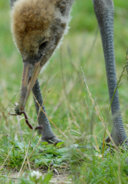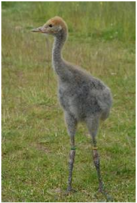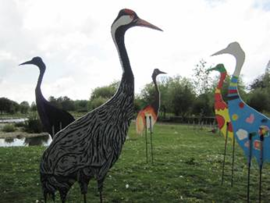Billy the bruiser rules the roost

Little Billy the bruiser rules the roost
A small crane, who makes slugs and worms his dish of the day, has emerged as the surprise leader of the pack at this year’s Crane School at WWT Slimbridge in Gloucestershire.
 Billy is one of the class of cranes being reared in the second year of the Great Crane Project.
Billy is one of the class of cranes being reared in the second year of the Great Crane Project.
As the cranes start to develop their personalities one nicknamed Billy has exhibited some rather unusual characteristics. Although he is among the smallest, it is the most dominant of the cranes.
Billy runs at the other cranes barging them out of his path and struts around the exercise field. He has also developed a strange taste for slugs and worms. As they begin to forage, most cranes learn early on to avoid eating slugs as they ooze a sticky substance which temporarily glues their beaks together.
But when rain starts to fall Billy excitedly starts to dash around the field picking up any slugs or worms he spots until his beak becomes stuck together for 15 minutes or so.
These cranes are being reared by humans disguised as adult (‘mum’ or ‘dad’)cranes at Slimbridge Wetland Centre, so they are well-equipped for life in the wild and learn to fear people.
Pensthorpe Conservation Trust warden and Crane dad, Roland Digby, said: “You would normally expect one of the larger cranes to be the most dominant so it is a funny situation. We’ve nicknamed him Billy the Bruiser as he chases or tries to fight any crane in his path, they are all scared of him!
“None of the other cranes would touch a slug or a worm so it is funny seeing Billy sprint around hunting for them – he really is one of a kind.“
around hunting for them – he really is one of a kind.“
The Great Crane Project, a partnership between WWT, RSPB and Pensthorpe Conservation Trust, with major funding from Viridor Credits Environmental Company hopes to re-introduce and establish a wild population of this iconic species in Somerset over the next ten years.
Using WWT’s renowned specialist conservation breeding expertise, the cranes were brought over as eggs collected from sustainable wild populations in Germany to WWT’s Slimbridge Wetland Centre in Gloucestershire, back in April. They will be released to join the cranes from the first year of the project in autumn this year.
While these cranes are being reared behind-the-scenes at Slimbridge, visitors are able to see plenty around the grounds.
Somerset Art Works has installed a number around the grounds featuring wire work, paper mache sculptures and over 60 life size painted crane cut-outs. SAW engaged artists Fiona Campbell, Kitty Hillier and Hilda Vaughan to lead a series of art workshops inspired by the Great Crane Project.
 School and community groups also had the opportunity to discover the wonders of cranes by visiting the RSPB’s wetland reserves in the area, appreciate the importance of the Somerset Levels habitat and learn about the re-introduction of this fascinating species which has missing from our wetlands for nearly 400 years.
School and community groups also had the opportunity to discover the wonders of cranes by visiting the RSPB’s wetland reserves in the area, appreciate the importance of the Somerset Levels habitat and learn about the re-introduction of this fascinating species which has missing from our wetlands for nearly 400 years.
To keep up to date with the Great Crane Project follow the news on the project’s website: www.thegreatcraneproject.org.uk.